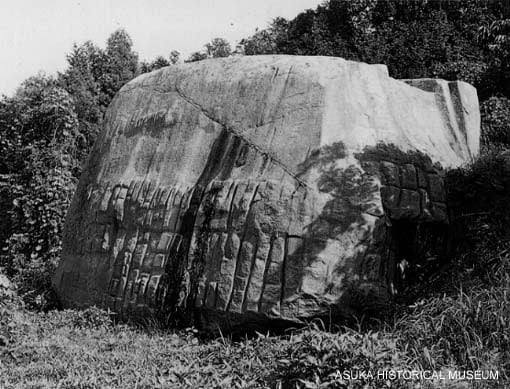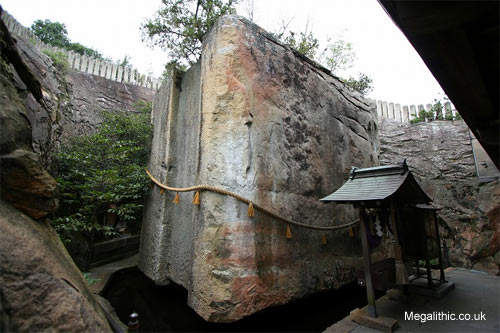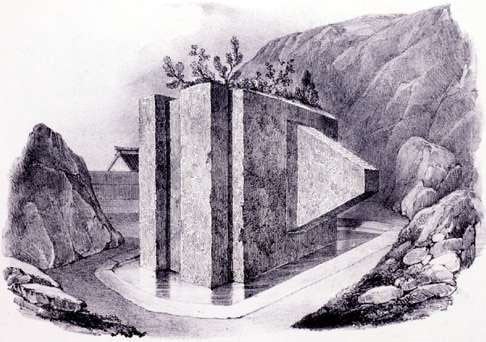The village of Asuka is located in the Takaichi District of the Nara Prefecture in Japan. Asuka is an ancient land with historical interest. It has its origins in the Tumulus Period (250-552 AD), also called Kofun jidai, which means Old Mound period. This era of Japanese history is characterised by a particular type of burial mound that was popular at the time; specifically key shaped earthen mounds surrounded by moats. One of the most unique features of Asuka is the multiple carved granite stones in peculiar shapes in various parts of the region. The largest and most unusual of the carved stones is the Masuda-no-iwafune (the 'rock ship of Masuda').
The stone carving, which stands near the top of a hill in Asuka, is 11 metres in length, 8 metres in width and 4.7 metres in height, and weighs approximately 800 tonnes. The top of has been completely flattened and there are two one-meter square holes carved into it and a ridge line that is parallel to both holes. At the base of the stone are lattice-shaped indentations which are believed to be related to the process that was used by the builders to flatten the sides of the rock.

So what is the nature of this rock and what is its purpose? Who made it, when and why? Unfortunately, there are no definite answers to those questions, but numerous suggestions have been put forward to account for this unique and unusual structure.
In the region in which Masuda no iwafune is found, there are many Buddhist temples and shrines that may suggest the carving was made by Buddhists, perhaps for some kind of religious or ceremonial purpose. However, Masuda no iwafune does not resemble the style or construction of any other Buddhist monument.
Another suggestion comes from the name of the rock itself, which translates to ‘the rock ship of Masuda’. It has been suggested that the stone was carved in commemoration of the building of Masuda Lake, which was once located nearby (now drained and part of Kashiwara City).
Another popular theory is that it was used as an astronomical observation point. Evidence for this perspective comes from the ridge line across the top of the rock which runs parallel to the mountain ridge in Asuka and lines up with the sunset on a certain day of the year called "spring doyou entry", which occurs 13 days after the sectional solar term ‘Pure Brightness’. This day was important in the lunar calendar and for early Japanese agriculture as it signalled the beginning of the agricultural season. However, this perspective has been largely dismissed by scholars who do not recognise it as an ancient astronomical observing station.
Some historians believe that the rock is just the remains of a tomb that was designed for members of the royal family. However, this does not explain the unusual features, such as the square holes on top, nor have any bodies been found. To account for this, some have suggested it was intended as the entrance of a tomb but was unfinished.
Interestingly, Masuda no iwafune bears a similarity to another stone block in Japan – the Ishi-no-Hoden megalith, which is situated in Takasago city. The Ishi-no-Hoden megalith measures 6.45m x 5.7 m x 5.45 m, and has similar ridges on the sides but without any visible holes – although some suggest that they are beneath the trees on the top of the rock.


Today, Ishi-no-Hoden is a shrine dedicated to the Shinto god Oshiko Jinja, but no one knows who originally built it and why.
Very little is known about the Masuda no iwafune stone carving and definitive evidence is still lacking with regards to who built it and why. The fact that there are so many other stone slabs and structures in the area suggests that the region was inhabited prior to the Tumulus period, but again, there is no proof to support this perspective. In the end, the true origin and purpose of these enigmatic features of ancient Japan may be lost to the pages of history.


No comments:
Post a Comment